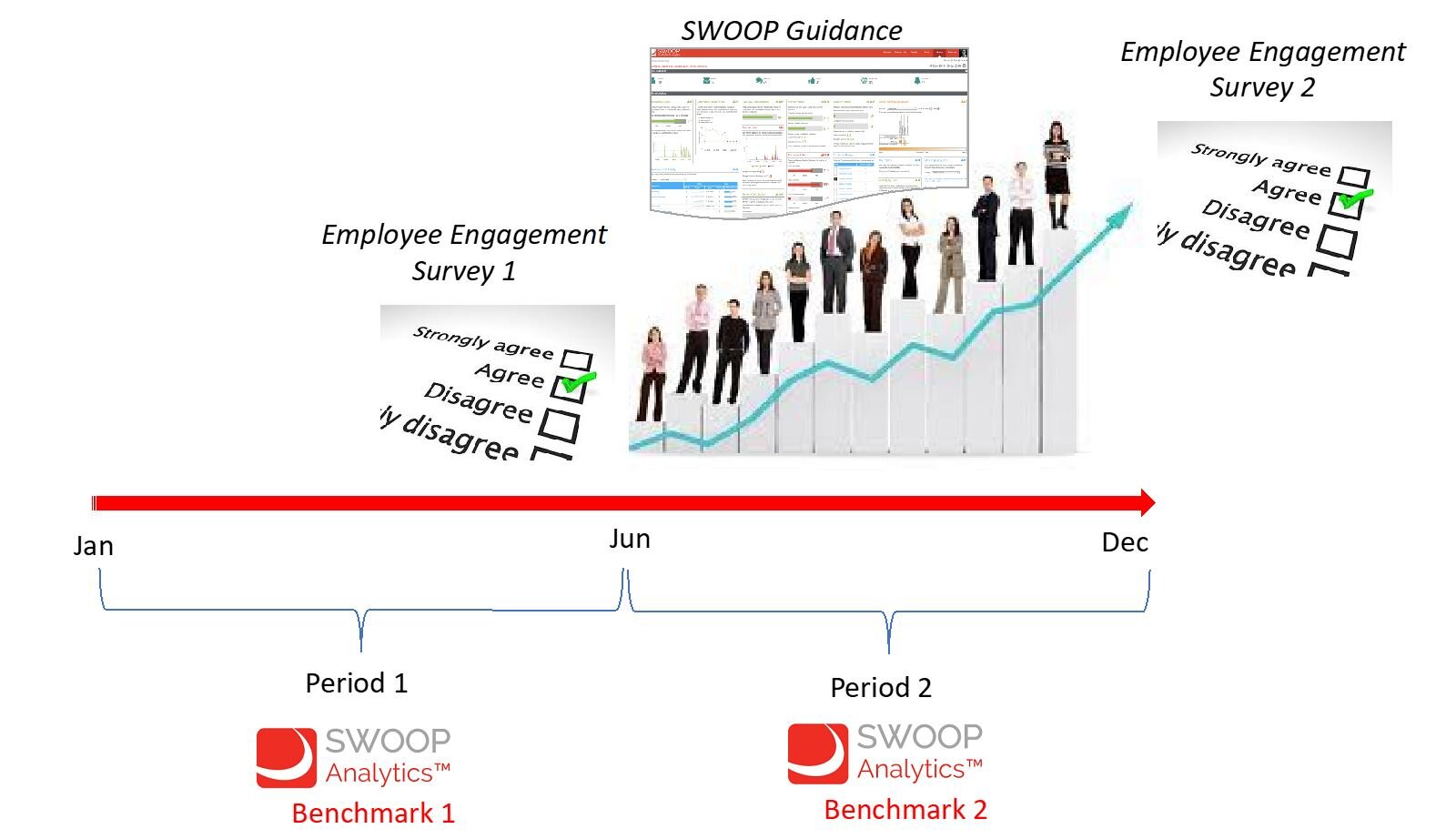It’s Official: SWOOP Metrics and Employee Engagement Surveys Results Align!
We always thought it would be the case, but emanating from our recent SWOOP Chat event in Sydney we now have evidence to show that what you see in SWOOP is reflected in what staff think and feel (Employee Engagement Survey) and subsequently in tangible business results (academic research).
Connecting SWOOP measures with Engagement Survey Results
Pete Johns, the Digital Employee Experience Manager at roadside assistance organisation NRMA, reported on a controlled experiment. Pete surveyed a staff division for its employee engagement levels in July of 2018. He then created several Yammer groups, which he coached in community building with the help of SWOOP’s analytics, and repeated the engagement survey three months later. The improvement results were spectacular, earning Pete and the NRMA the global Gartner Small Idea, Big Impact award for 2019.
We saw the opportunity to assess our SWOOP benchmarks against employee engagement survey results. By retrospectively benchmarking the six months prior to the first survey, and following this with a benchmarking of the next six month period, we could precisely align our SWOOP results with the survey results.
The engagement survey had been designed to align with the SWOOP maturity model which places certain SWOOP measures at each stage of the maturation journey:
And here are the comparative results received:
*The lower connecting score is attributed to the Personas being proportions i.e. a rise in one results in a fall in the others. The increase in the aspirational %Engager persona was an impressive 33% though.
The difference in the %change between the survey and the SWOOP measures relates to the limitation of the five point Likert scale used in the survey, providing less scope for large changes. The SWOOP measures can use a full 100 point scale and therefore is able to amplify the actual changes that took place; in fact making an already good story look even better!
The SWOOP results cover the whole organisation, so the good news is not just confined to the targeted division.
We can also see the largest positive changes were achieved for the Social Media phase (Platform Adoption and User Engagement), with changes in the Social Networking phase (Connecting and Sharing) and Job Fulfilment phase (Solving and Innovating) achieving lower %change respectively, reinforcing the maturation effect where the latter phases are more challenging to achieve.
While this is only a single case, it does illustrate that SWOOP could potentially reduce the need to survey for employee engagement insights, with something that can provide engagement insights across the whole enterprise in close to real time.
Connecting ESN usage and Employee Engagement
While there are a plethora of claims to this connection, we have been working with Griffith University to provide more robust evidence to this hypothesised linkage. Griffith University undertook a comprehensive literature review to assess the current academic evidence available.
At SWOOP Chat Sydney 2018, Prof Nick Barter presented on empirical research conducted on post graduate online business students using Yammer for their course. He was able to build a direct link between SWOOP’s preferred behavioural personas and performance as assessed by their final grades. This result triggered broader thinking on the concept of student ‘engagement’ in the course as well as with their peer students; in essence, mimicking employee engagement within enterprises. To build a foundation beneath these early empirical results, Griffith University has undertaken a systematic literature review looking for any evidence of a link between ESN usage and employee engagement.
Some key points from the literature review are:
ESNs have positive impacts on communication, information and knowledge sharing, accessibility to resources, collaboration, connection, belonging and self-efficacy.
The above effects can be mediated by engagement levels of the leaders, flatness in the hierarchy, organisational trust, open cultures and support for ESN usage. In other words, their presence can accelerate engagement, while their absence can dampen or negate employee engagement benefits.
No negative effects for an ESN were found.
Cause and effect yet to be proven i.e. does the ESN create more engaged employees or are engaged employees more likely to use the ESN?
Connecting Employee Engagement and Performance
There is no shortage of stories and anecdotes connecting ESN usage to positive business outcomes. You need look no further than SWOOP’s rich library of case studies.
This interview conducted by Pete Johns with one of the leaders from his experiment at NRMA is representative of many other cases we have identified.
The Griffith University literature review also uncovered a large study undertaken across 36 companies and almost 8,000 business units that found higher engagement levels had led to between $80k-120k additional revenue/month/business unit.
We think that as a result of the research work undertaken by Griffith University and SWOOP we can now say with some confidence that ESN usage is linked with employee engagement, which in turn is linked with business performance. And through our work with the NRMA, we now have a link between employees’ interactions on their ESN, as measured by SWOOP, and how engaged they feel at work.
We do however appreciate that one swallow does not a summer make. There is still much work to do. Does the linkage hold up for different employee engagement survey types? What measurable impact does leadership style have? And of course, there is the ever-present issue of cause and effect.
If you are a SWOOP user and have recently completed an engagement survey exercise, we would love to hear from you.





